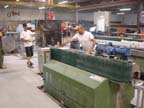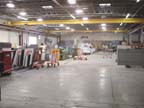
Some of the most solid growth has been in recent years. Business increased over 30% percent in 2002; 27% in 2003; 9% last year; and, year to date in 2005, the company has already exceeded 30% growth. Today, the company employs nearly 220 people in two Kansas City facilities - totaling over 70,000 square feet - plus another in Wichita, KS, and it is looking to expand again. Using automated machinery, the company produces nine or 10 kitchens in one 8-hour shift each day. A fleet of 40 vehicles services a customer base that sprawls over 200 miles.
“If you want to grow, you really need automated machinery,†said Lead Machinist Mike Lawrence. “In this kind of business, doing this kind of production, you couldn't get by without it. The fabricators couldn't possibly keep this pace, and their quality wouldn't be as good. Our automated equipment saves so much time, and it just makes our work so much easier.â€

Expanding locations
Top Master's main facility in Kansas City is a 46,000-square-foot building, and it is dedicated to solid surface and engineered stone. The facility works with DuPont Corian, Silestone®, Zodiaq® and other manmade surface materials. Lawrence noted that Top Master is one of the largest fabricators in the area, which has become a big and growing market for quartz surfaces. To help meet demand for these products, the company moved its natural stone operations to a separate 24,000-square-foot facility, also in Kansas City. In Wichita, the company's third facility works with both solid surface and stone products.Lawrence credits much of the company's growth to quartz, and he attributes the growing quartz business to increasing customer awareness. “I think that the popularity of quartz products right now is because consumers are more educated about the benefits and the properties of quartz versus natural stone,†he said. “The manufacturers of Silestone and Zodiaq are taking a proactive approach by doing national advertising. We positioned ourselves as one of the first Zodiaq fabricator/installers in the country when it came out some five years back, and we've been riding the wave of its growing popularity ever since.â€
Of course, natural stone is also a key component of Top Master's business. “At the time I started working here, we were doing mostly granite and some marble,†Lawrence said. “Then we started getting into the engineered stone, and we had such a market that the granite was holding up the Silestone and the Zodiaq fabrication. So, we moved our granite operations to another building, so we could up the sales and production of the engineered stone.â€
While most of Top Master's business is residential, the company is expanding into more commercial work. Recent commercial projects have included Brewer Fieldhouse at the University of Missouri in Columbia, the new Kansas City Public Library, the food service facility at Hallmark Cards' world headquarters and work at the world headquarters of Sprint Communications.

Equipping the facilities
At both Kansas City facilities, the heart of the machine area is the bridge saw. There are two in the main building, and two in the granite facility. All four are HTO-1B models from Marmo Machinery USA. Each saw has a large cutting area of 140 x 140 inches. The 7-foot bridge height allows an operator access without having to bend over to walk beneath the grid, and the saws were supplied with a hydraulic tilt table. Each of the saws is built to cut 10 or more slabs of granite, marble, porcelain or engineered stone per 10-hour shift. This keeps the other machines supplied for edging, shaping and other operations.“The main advantage of these saws is time,†Lawrence said. “They're computer controlled, so you just set it up, stand back and let it go. It'll cut across the slab, pick up, go back, move over, sit down, cut across, and it keeps going until it's all cut.â€
For edging, shaping and other operations, Top Master also has equipment from Marmo Machinery. This includes two LCV 711 flat edge-polishing machines, one in each building. It also includes four LCT 522 vertical polishing machines for edging operations, two in each building. The LCT machines are capable of seven or eight bullnose profiles at the touch of a keypad. They can also polish squared off and inclined edges as well as toroidal edges and other convex shapes.
“The LCT saves so much time,†he said. “If we had to do it by hand, it would be triple or quadruple the time. I can run a 120-inch piece through my machine in 20 to 25 minutes. It would probably take a fabricator an hour and a half to two hours to do it by hand. The edge is also consistent. If you run two or three thicknesses in one job, there might be a little variance in the bottom side of the edge, but the fabricator will grind and feather that out, so they all match.
“You can run the pieces through the flat polisher even faster. I can speed it up by adjusting the belt speed and still put out a good edge compared to the shaper. The shaper just has to work slower because it has more work to do. But I can back the pieces and keep it running continuously as long as I don't have to change an edge. To change an edge, you've got to change the profile wheel for either the bullnose or the waterfall if it is needed. You've got to set the bevelers when the piece goes into the machine. Some edges use those; some don't. After that, you program the machine to tell it what edge it's going to run. And then I usually run a test piece because we try to get as close to a set measurement as we can. All it takes is about five minutes to change from one edge to another.â€
He noted that Top Master deals mostly with 3-cm-thick material and some 2 cm thick. The company will do any kind of edge, but complex shapes, like the laminated ogee, must be done by hand. Typical edges run on the LCT include a top bevel, a 3â„8-inch top and bottom bevel, a full bullnose and the waterfall, sometimes called a “demi-bull†or “half-bull.†The LCV 711 polishes flat edges, typically the top edge of a backsplash.

From slab to finished top
Operations are much the same at both the main building and the granite shop. Outside the main building, Top Master keeps in stock some 10 to 12 varieties of quartz surfacing stone in each of the most popular colors, plus some of the less popular colors. From this storage area, a slab goes to a layout table, where a fabricator draws shapes on the slab from templates. It is then rolled to the saw area for cutting, and the pieces are then placed in their own cart to keep each job separate. Two Marmo overhead cranes on one set of rails move the workpieces. One handles all of the material in the saw area, and the other is used in the machine area.“The whole set-up is kind of a U shape,†Lawrence said. “Where the rock comes in, it'll go to the layout table, and then it'll go to the end of the building where the two saws are. And then after that are the shapers and the flat polishing machines. The fabricators are down at the other end of the building.†He noted that each saw has its own operator, while the two shapers and polisher are run by two operators. The shop has 15 fabricators for finishing, and other operations that must be done by hand.

Uptime is key
Lawrence noted that the machines run continuously during every shift. They require little more than routine maintenance to keep them running. “The machines run all day except when they let me take breaks,†he said. “We usually do an 8-hour day. Sometimes, if we've got a really busy day, it might take 12 hours. We take a 45-minute lunch and a couple of 15-minute breaks. So other than that, they run all day long.“As the machines age, I pay attention to weekly maintenance a bit more,†Lawrence continued. “You have to grease them and change the pads that do the actual polishing when they wear out. Sometimes I've got to change the nylon rollers. Nothing major ever breaks. I keep spare parts in stock and can usually fix just about anything. If there's something really difficult, deep down in the machine, then we'll get Marmo out of [Michigan] and have them come down here, or even figure out the problem over the phone.â€
Although Top Master has no room for any additional machinery, it may be a consideration in the not-too-distant future. As business continues to grow, both the natural stone and engineered stone operations may again be under one roof in a bigger building that will help the company expand production to meet demand.
Top Master, Inc.
Kansas City, KS
Type of work: Countertops in solid surface, quartz surfacing and natural stone; commercial fabrication
Machinery: 4 HTO-1B bridge saws from Marmo Machinery; two LCV 711 flat edge-polishing machines from Marmo Machinery; four LCT 522 vertical polishing machines from Marmo Machinery
Number of Employees: 220
